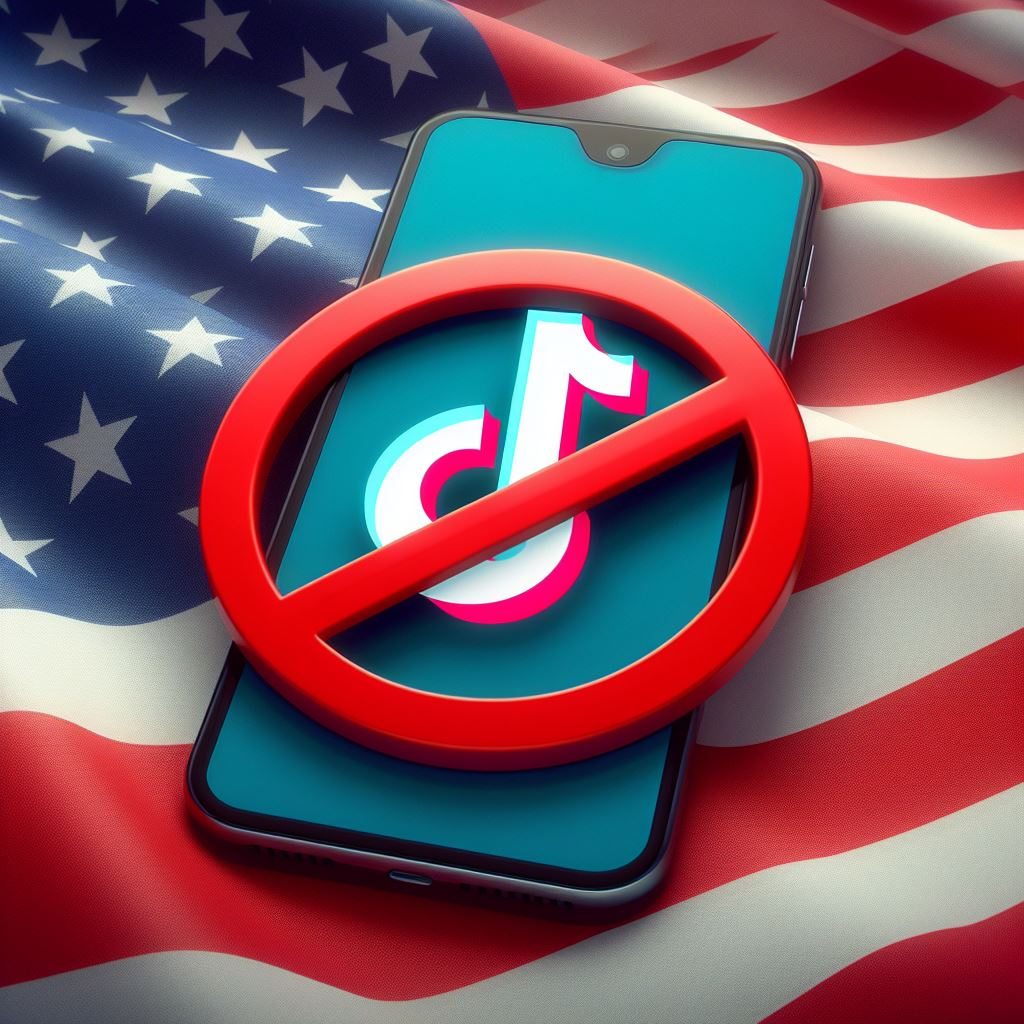The House of Representatives has passed legislation that would ban the popular social media platform TikTok in the United States if its China-based owner, ByteDance Ltd., does not sell its stake within a year. However, the app is unlikely to disappear anytime soon.
Is TikTok going to be banned?
Key Points:
- The decision by House Republicans to include TikTok as part of a larger foreign aid package, a priority for President Joe Biden with broad congressional support for Ukraine and Israel, fast-tracked the ban after an earlier version had stalled in the Senate.
- A standalone bill with a shorter, six-month selling deadline passed the House in March by an overwhelming bipartisan vote as both Democrats and Republicans voiced national security concerns about the app’s owner, the Chinese technology firm ByteDance Ltd.
- The modified measure, passed by a 360-58 vote, now goes to the Senate after negotiations that lengthened the timeline for the company to sell to nine months, with a possible additional three months if a sale is in progress.
- Members of both parties, along with intelligence officials, have worried that Chinese authorities could force ByteDance to hand over American user data or direct the company to suppress or boost TikTok content favorable to its interests.
- TikTok has denied assertions that it could be used as a tool of the Chinese government and has said it has not shared U.S. user data with Chinese authorities.
- The U.S. government has not publicly provided evidence that shows TikTok shared U.S. user data with the Chinese government or tinkered with the company’s popular algorithm, which influences what Americans see.
- TikTok has good reason to think a legal challenge could be successful, having seen some success in previous legal fights over its operations in the U.S. In November, a federal judge blocked a Montana law that would ban TikTok use across the state after the company and five content creators who use the platform sued.
Age Distribution of TikTok Users Worldwide
- 10-19 years old: 25%
- 20-29 years old: 22.4%
- 30-39 years old: 21.7%
- 40-49 years old: 20.3%
- 50+ years old: 11%



маркетплейс аккаунтов соцсетей купить аккаунт с прокачкой
маркетплейс аккаунтов купить аккаунт с прокачкой
магазин аккаунтов перепродажа аккаунтов
аккаунты с балансом https://ploshadka-prodazha-akkauntov.ru/
маркетплейс аккаунтов соцсетей магазин аккаунтов
аккаунты с балансом купить аккаунт
маркетплейс аккаунтов гарантия при продаже аккаунтов
Account Purchase Accounts market
Account Store Website for Selling Accounts
Verified Accounts for Sale Buy Account
Sell accounts Social media account marketplace
Account marketplace Ready-Made Accounts for Sale
Account Trading Platform Accounts marketplace
Buy and Sell Accounts Accounts for Sale
Buy accounts Marketplace for Ready-Made Accounts
Secure Account Purchasing Platform Database of Accounts for Sale
Online Account Store Account Purchase
ready-made accounts for sale account trading platform
accounts for sale secure account sales
sell pre-made account account buying service
ready-made accounts for sale account trading
account buying service account catalog
accounts marketplace account exchange service
find accounts for sale online account store
account buying service account selling service
verified accounts for sale account buying service
account store online account store
buy accounts account buying platform
secure account purchasing platform find accounts for sale
guaranteed accounts verified accounts for sale
accounts for sale find accounts for sale
account buying service secure account sales
accounts market marketplace for ready-made accounts
sell account online account store
sell pre-made account account market
verified accounts for sale account market
website for selling accounts sell pre-made account
account trading platform account catalog
sell account database of accounts for sale
account trading platform account exchange
account exchange service guaranteed accounts
account trading service account marketplace
online account store account trading service
account catalog https://accounts-offer.org/
ready-made accounts for sale https://accounts-marketplace.xyz
online account store accounts market
accounts market https://social-accounts-marketplace.xyz/
account store https://buy-accounts.space
account store https://buy-accounts-shop.pro
social media account marketplace https://buy-accounts.live
account trading platform accounts-marketplace.online
account purchase https://social-accounts-marketplace.live
profitable account sales https://accounts-marketplace-best.pro
продажа аккаунтов https://akkaunty-na-prodazhu.pro
покупка аккаунтов rynok-akkauntov.top
магазин аккаунтов https://kupit-akkaunt.xyz/
маркетплейс аккаунтов https://akkaunt-magazin.online
продать аккаунт https://akkaunty-market.live/
покупка аккаунтов https://kupit-akkaunty-market.xyz
маркетплейс аккаунтов соцсетей https://akkaunty-optom.live/
биржа аккаунтов https://online-akkaunty-magazin.xyz/
маркетплейс аккаунтов https://akkaunty-dlya-prodazhi.pro
площадка для продажи аккаунтов kupit-akkaunt.online
facebook ad accounts for sale https://buy-adsaccounts.work
buy facebook profiles https://buy-ad-accounts.click
buy accounts facebook https://buy-ad-account.top
facebook accounts to buy facebook ads account for sale
buy facebook advertising accounts https://ad-account-buy.top/
buy facebook ad account buy fb account
facebook account buy ad-account-for-sale.top
buy a facebook ad account buy facebook accounts cheap
buy ad account facebook https://ad-accounts-for-sale.work
google ads accounts https://buy-ads-account.top
buy google adwords accounts https://buy-ads-accounts.click
cheap facebook accounts https://buy-accounts.click
buy aged google ads accounts https://ads-account-for-sale.top
buy google ads threshold account buy google ads threshold account
buy google ads invoice account google ads accounts for sale
buy google ads agency account https://buy-account-ads.work
google ads agency accounts https://buy-ads-agency-account.top
buy verified google ads accounts buy account google ads
google ads account buy buy google ads agency account
verified bm https://buy-business-manager.org
buy google ads verified account google ads account seller
buy facebook verified business manager https://buy-bm-account.org
unlimited bm facebook facebook verified business manager for sale
facebook business manager buy buy-verified-business-manager.org
facebook business manager buy https://buy-business-manager-acc.org
buy fb bm business-manager-for-sale.org
facebook business manager for sale facebook business manager account buy
buy verified bm buy facebook verified business account
facebook business manager buy verified business manager for sale
tiktok agency account for sale https://buy-tiktok-ads-account.org
facebook bm for sale verified-business-manager-for-sale.org
tiktok ads account buy https://tiktok-ads-account-buy.org
tiktok ad accounts buy tiktok ads accounts
tiktok ads account buy https://tiktok-agency-account-for-sale.org
buy tiktok ad account https://buy-tiktok-ad-account.org
buy tiktok business account https://buy-tiktok-ads-accounts.org
buy tiktok business account https://tiktok-ads-agency-account.org
buy tiktok business account https://buy-tiktok-business-account.org
tiktok ad accounts https://buy-tiktok-ads.org
buy fb ads account account acquisition account purchase
levitra pills online [url=https://levinevino.com]generic vardenafil 20mg[/url] levitra 20mg
generic levitra uk levitra 20mg france levitra doctor online
facebook ad account buy gaming account marketplace verified accounts for sale
I haven?¦t checked in here for some time as I thought it was getting boring, but the last few posts are great quality so I guess I?¦ll add you back to my everyday bloglist. You deserve it my friend 🙂
**mind vault**
mind vault is a premium cognitive support formula created for adults 45+. It’s thoughtfully designed to help maintain clear thinking
I do love the manner in which you have framed this challenge and it does supply us a lot of fodder for thought. Nevertheless, because of everything that I have personally seen, I simply just trust when the reviews pile on that people continue to be on point and don’t embark on a tirade regarding the news of the day. Yet, thank you for this exceptional piece and although I do not agree with it in totality, I respect the point of view.
**sugarmute**
sugarmute is a science-guided nutritional supplement created to help maintain balanced blood sugar while supporting steady energy and mental clarity.
**prostadine**
prostadine is a next-generation prostate support formula designed to help maintain, restore, and enhance optimal male prostate performance.
**gl pro**
gl pro is a natural dietary supplement designed to promote balanced blood sugar levels and curb sugar cravings.
**prodentim**
prodentim an advanced probiotic formulation designed to support exceptional oral hygiene while fortifying teeth and gums.
**nitric boost**
nitric boost is a dietary formula crafted to enhance vitality and promote overall well-being.
**glucore**
glucore is a nutritional supplement that is given to patients daily to assist in maintaining healthy blood sugar and metabolic rates.
**vittaburn**
vittaburn is a liquid dietary supplement formulated to support healthy weight reduction by increasing metabolic rate, reducing hunger, and promoting fat loss.
**synaptigen**
synaptigen is a next-generation brain support supplement that blends natural nootropics, adaptogens
**mitolyn**
mitolyn a nature-inspired supplement crafted to elevate metabolic activity and support sustainable weight management.
**zencortex**
zencortex contains only the natural ingredients that are effective in supporting incredible hearing naturally.
**yusleep**
yusleep is a gentle, nano-enhanced nightly blend designed to help you drift off quickly, stay asleep longer, and wake feeling clear.
**wildgut**
wildgutis a precision-crafted nutritional blend designed to nurture your dog’s digestive tract.
**breathe**
breathe is a plant-powered tincture crafted to promote lung performance and enhance your breathing quality.
**energeia**
energeia is the first and only recipe that targets the root cause of stubborn belly fat and Deadly visceral fat.
**pineal xt**
pinealxt is a revolutionary supplement that promotes proper pineal gland function and energy levels to support healthy body function.
**boostaro**
boostaro is a specially crafted dietary supplement for men who want to elevate their overall health and vitality.
**prostabliss**
prostabliss is a carefully developed dietary formula aimed at nurturing prostate vitality and improving urinary comfort.
**potentstream**
potentstream is engineered to promote prostate well-being by counteracting the residue that can build up from hard-water minerals within the urinary tract.
**hepato burn**
hepato burn is a premium nutritional formula designed to enhance liver function, boost metabolism, and support natural fat breakdown.
**hepatoburn**
hepatoburn is a potent, plant-based formula created to promote optimal liver performance and naturally stimulate fat-burning mechanisms.
**flowforce max**
flowforce max delivers a forward-thinking, plant-focused way to support prostate health—while also helping maintain everyday energy, libido, and overall vitality.
**prodentim**
prodentim is a forward-thinking oral wellness blend crafted to nurture and maintain a balanced mouth microbiome.
**cellufend**
cellufend is a natural supplement developed to support balanced blood sugar levels through a blend of botanical extracts and essential nutrients.
**revitag**
revitag is a daily skin-support formula created to promote a healthy complexion and visibly diminish the appearance of skin tags.
**neuro genica**
neuro genica is a dietary supplement formulated to support nerve health and ease discomfort associated with neuropathy.
**sleeplean**
sleeplean is a US-trusted, naturally focused nighttime support formula that helps your body burn fat while you rest.